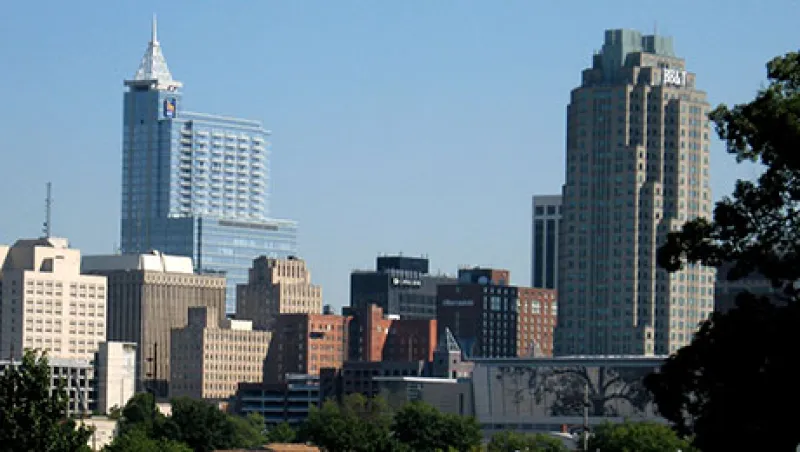There’s an adage in real estate: As job growth goes, so goes the office market. And as U.S. job growth has strengthened over the past 18 months, so has the office real estate market.
“Job growth acceleration has been a shot in the arm,” says Jed Reagan, an analyst with Green Street Advisors, a research firm covering real estate and real estate investment trusts in Newport Beach, California. “Office demand is picking up, while supply increases are moderate. That works toward getting office real estate in the sweet spot.”
The U.S. economy added nearly 3 million jobs last year, and payroll increases averaged 208,000 a month in the first half of this year. As for office space, the national vacancy rate stood at 16.6 percent in the second quarter, matching the level of the first quarter, which was the lowest since the third quarter of 2009, according to New York–based real estate research firm Reis. Rents rose 0.7 percent in the second quarter and 3.2 percent over the past 12 months. But those aren’t the numbers of a market going gangbusters. “Overall, it’s a recovery, but I wouldn’t characterize it as particularly strong,” says Ryan Severino, senior economist in the research and economics department at Reis. A healthy vacancy rate would be more like 11 to 13 percent, he says, adding, “We’re still dealing with the fallout of the [2009] recession.”
One problem facing the office real estate market is the trend of companies using less space per employee as employers shift from individual offices and high-walled cubicles toward an open-plan or hot desking layout. In addition to the opinion that such an office design fosters collaboration, there is also the reality that it allows companies to cut back on rental costs. Moreover, job cuts were so severe during the financial crisis that even in situations in which companies have since added jobs, they had room to spare. But now, says Reagan, “companies are feeling more optimistic about the economy and their growth prospects, so they are more comfortable committing to large amounts of office space.”
Occupied office space totaled 15.607 million square feet in the first half of the year, the highest total since the financial crisis and up 22 percent from the year-earlier period, according to Reis. On the supply side, new construction totaled 14.1 million square feet in the first half, up 4 percent from a year earlier. Supply has risen much more moderately over the past six years than in the 1980s and ’90s, says Reagan: “For the most part supply can be readily absorbed.”
Investors are banking on sustained growth in office real estate as well. Sales of office properties rose 38 percent in the first five months of the year from the same period of 2014, according to the New York–based real estate research firm Real Capital Analytics. Prices climbed 4.1 percent in the first quarter and 16.8 percent in the year ending March 31. “Investors are looking at other options in the economy and seeing the yield available in the office sector,” says senior vice president Jim Costello. “They want income.”
Office property sales offered an average capitalization rate of 6.7 percent over the 12 months through May, which compares well with returns on fixed-income instruments. The ten-year Treasury note yields 2.30 percent, for example. “To the extent there’s growth in the economy, it’s in the knowledge sector,” Costello says. “If you want to capture the gains of that sector, one way is to own the office space where all these knowledge workers need to congregate.”
In terms of individual markets, cities with a strong technology bent, such as San Francisco, San Jose, New York and Austin, Texas, are seeing the most strength in their office markets. Other regions to watch include Atlanta, Dallas, North Carolina’s Research Triangle region and Nashville, Tennessee. All four of those metropolitan areas are benefiting from strong growth in jobs and new infrastructure and increasing numbers of newcomers seeking warm weather and a lower cost of living. Other cities with a knowledge-based workforce are faring well, such as Chicago, Los Angeles and Washington, says Reagan. Markets that are seeing a slump in office real estate include Houston, where energy companies have taken a wallop from the slump in oil prices, as well as some markets that led the housing boom of the 2000s, such as Las Vegas and Phoenix. In general, says Reagan, office real estate in urban cores is performing better than the office park properties in suburbs.
Looking forward, analysts expect the U.S. office market to continue strengthening. “I’m generally optimistic, as long there’s no recession, which we don’t foresee,” says Reis’s Severino. He looks for the vacancy rate to fall by 2.5 to 3 percentage points over the next four to five years and for rent growth to accelerate from its current 3 percent annual rate. The outlook is bright on the investment side too. “There is still tremendous capital worldwide looking for a safe and stable yield,” says Real Capital’s Costello. “Commercial real estate will continue to receive attention.”







